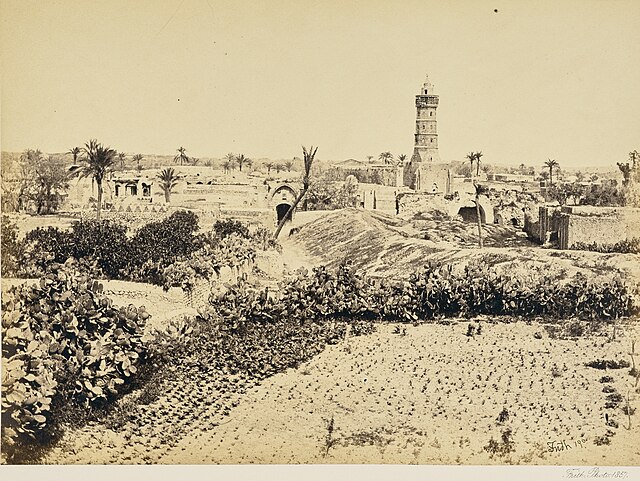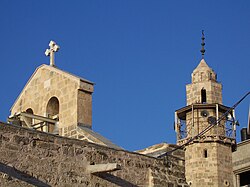Top Qs
Timeline
Chat
Perspective
Old City of Gaza
Historical city center of Gaza, Palestine From Wikipedia, the free encyclopedia
Remove ads
The Old City of Gaza is the historical center of Gaza City, in the Gaza Strip. For much of recorded history it has been the southernmost coastal city in the region of Palestine, occupying a strategic position on the ancient trade route the Via Maris, between Egypt and the Levant. Throughout its history, Gaza has been ruled by various empires, including the Philistines, Egyptians, Assyrians, Babylonians, Romans, and Ottomans.[1] Following Israeli bombardment during the ongoing Gaza–Israel conflict, the Old City has been described in 2024 as "a vast field of ruins".[2]
Remove ads
History
Summarize
Perspective


The city's origins trace back to around 3000 BCE, when it was first established by the Canaanites. Gaza rose to prominence due to its location on the Via Maris trade route that links Africa and Asia, serving as a hub for merchants and travelers. Like the wider region, it subsequently fell under the control of the Egyptian, Assyrian, and the Persian empires. Alexander the Great captured the city in 332 BC following a siege which killed most of the inhabitants. The area changed hands regularly between two Greek successor-kingdoms, the Seleucids of Syria and the Ptolemies of Egypt, with a particularly notable battle in 312 BC, until it was besieged and taken by the Hasmoneans in 96 BC. The city was rebuilt by Roman General Pompey, and maintained its prosperity throughout the Roman period, receiving grants from several different emperors. It grew as a center for the trade of spices and perfumes during this period.[1]
The city's conversion to Christianity was spearheaded and completed under Saint Porphyrius, who destroyed its eight pagan temples between 396 and 420 AD. Gaza was conquered by the Muslim general Amr ibn al-As in 637 AD and most Gazans adopted Islam during early Muslim rule. The Crusaders wrested control of Gaza from the Fatimids in 1100, but were driven out by Saladin's forces in a battle in 1239. The city was destroyed during the Mongol raids into Palestine; it was the Mongol's southernmost point of conquest. Gaza was in Mamluk hands by the late 13th century, and became a regional capital. Under the Ottomans the city continued as the regional capital of the Gaza Sanjak, and witnessed a golden age under the Ridwan dynasty from c.1560-1690. Gaza was culturally dominated by neighboring Egypt from the early 19th century; Muhammad Ali of Egypt conquered it and most of Palestine in 1832.[3] When World War I erupted in 1917, British forces were defeated by the Ottomans in the first and second Battle of Gaza. General Edmund Allenby, leading the Allied Forces, finally conquered Gaza in a third battle.[4]
The city expanded outside of the area of the Old City during the twentieth century. In modern times, much of the Old City was destroyed by Israeli bombardment during the ongoing Gaza–Israel conflict.[2]
Remove ads
Neighborhoods
Summarize
Perspective
The Old City of Gaza is divided into four main quarters, some of which have subdivisions. Three of these quarters — Tuffah, Daraj, and Zaytun — were located within the walls of the ancient city, while the southeastern quarter, Shuja'iyya, developed later, mostly outside its walls:[5]
- Daraj Quarter ("The Stairs Quarter"): Located in the northwest (generally west), this is the oldest part of the city, sometimes referred to as the old city of Gaza proper. It is known for its narrow streets and traditional homes. It sits on an hill about 20 meters above the surrounding plain and other parts of the city. The name likely comes from the stairs that led up to it or the sensation of climbing stairs when approaching the area.[5]
- Zaytun Quarter ("The Olive Quarter"): Situated in the southwest (generally south), this quarter is named after its historical olive groves. It is the largest quarter within the old city walls. It contains the St. Porphyrius Church. The medieval Khan az-Zayt formed the historical border between the Zaytun Quarter and the Daraj Quarter; this was demolished under Djemal Pasha during the later years of Ottoman rule, and replaced with a road currently named Umar al-Mukhtär Street which now forms the boundary between the two quarters.[5]
- Tuffah ("The Apple Quarter"): Located in the northeast (generally north), this quarter is known as the Apple Quarter. The southern part of this quarter, called ad-Dabbäghah, was historically the tanners' neighborhood, which was situated near the Ottoman-era slaughterhouse.[5]
- Shuja'iyya: This southeastern quarter, which developed during the Middle Ages, mostly lies outside the ancient city walls. Its location outside the walls allowed it to expand significantly, eventually surpassing the Zaytun Quarter in size. The quarter is subdivided into two parts: al-Judaydah (also known as Saja'iyyat al-Akrād, or "The Saja'iyyah of the Kurds") in the northeast and at-Turkmän in the south.[5]
Remove ads
Architecture and landmarks
The Old City of Gaza is renowned for its architectural landmarks, many of which date back to the Mamluk and Ottoman periods. The dense urban fabric includes mosques, churches, bathhouses, and markets that showcase a blend of Byzantine, Mamluk, and Ottoman architectural styles. Despite modern development, the Old City retains many elements of its historical layout.[6]
- Great Mosque of Gaza (Al-Omari Mosque) – Originally a Byzantine church, converted into a mosque during the Islamic period.[6]
- Church of Saint Porphyrius – A Byzantine-era church serving the local Greek Orthodox community.[6]
- Sayed al-Hashim Mosque – said to contain the tomb of Hashim ibn Abd al-Manaf, Muhammad's great grandfather who died in Gaza.[6]
- Hamam al-Sammara – A traditional bathhouse from the Mamluk period.[6]
- Qasr al-Basha (Napoleon's Fort) – An Ottoman palace where Napoleon Bonaparte is said to have stayed.[6]
- Gold Market (Souk Al-Qaysariyya) – A historic market specializing in gold and jewelry.[6]
- Old City Walls – Remnants of the fortifications that once encircled the city.[6]
Maps and images
- 500s CE Madaba Map
- 700s CE Umm ar-Rasas mosaics
- 1799, Carte de l'Égypte, showing the battles during the French invasion of Egypt and Syria
- 1840–41 Royal Engineers
- 1887-88, Georg Gatt 1–5,000,
- 1931, Survey of Palestine 1–10,000
- 1937, Survey of Palestine 1–2,500
See also
Bibliography
- Al-Qeeq, Farid (2011-03-01). "A Comprehensive Approach to Incorporate Architectural Heritage of Gaza Old City into Contemporary Urban Fabric". Lonaard Journal. 1 (2): 109-. ISSN 2045-8150. Retrieved 2024-09-28.
- Al-Qeeq, Farid S (2009-01-01). "A Sustainable Approach for Urban Integration of Hammam Sammrah in the Historic City of Gaza". International Journal of Architectural Research: Archnet-IJAR. Retrieved 2024-09-28.
- Clarke, Joanne; Steel, Louise; Sadeq, Moain (2004). "Gaza Research Project: 1998 Survey of the Old City of Gaza". Levant. 36 (1). Informa UK Limited: 31–36. doi:10.1179/lev.2004.36.1.31. ISSN 0075-8914.
- Gatt, Georg (1888). "Legende zum Plane von Gaza". Zeitschrift des Deutschen Palästina-Vereins. 11. Deutscher Verein zur Erforschung Palästinas: 149–159. ISSN 2192-3124. JSTOR 27928513. Retrieved 2024-09-22.
- Sharon, Moshe (2009). "Gaza". Corpus Inscriptionum Arabicarum Palaestinae. Vol. 4. BRILL. pp. 15–213. ISBN 978-90-04-17085-8.
Remove ads
References
Wikiwand - on
Seamless Wikipedia browsing. On steroids.
Remove ads












